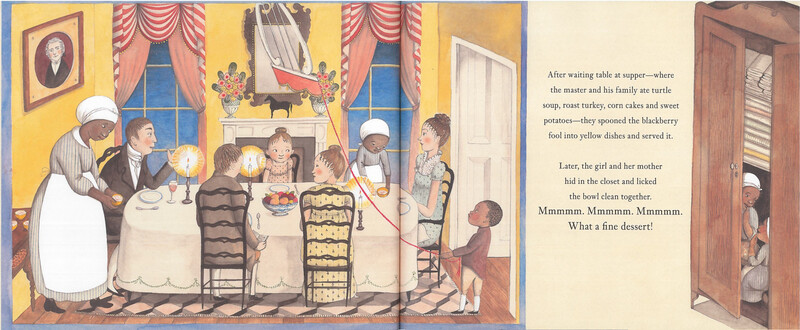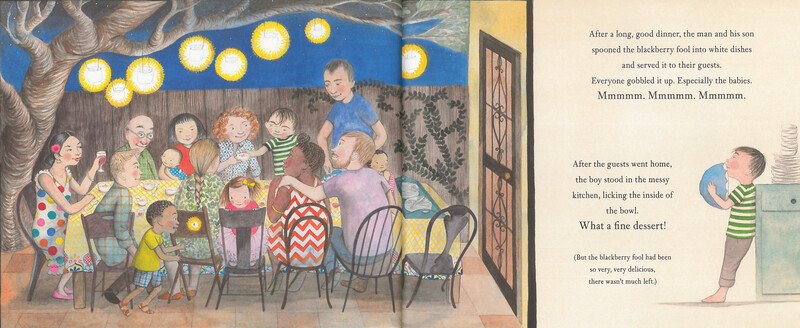A Fine Dessert: Four Centuries, Four Families
Item- Title
- A Fine Dessert: Four Centuries, Four Families
- Description
-
A Fine Dessert is a picturebook about four families who make blackberry fool, a fruit and whipped cream dessert. Each family cooks in a different time and place, showing four centuries of cultural change, from Lyme, England (1710), to Charleston, South Carolina (1810), to Boston, Massachusetts (1910), to San Diego, California (2010). A Fine Dessert received positive reviews at its publication, but readers pushed back online by questioning how black children may feel when reading about an enslaved black girl and her mother in Charleston, South Carolina (1810). The two occasionally smile while they work, and they make the desert for a white family, then lick the bowl while hiding in a linen closet (Thomas, Reese, and Horning, 2016, pp. 6-11).
Despite the association of sweet treats with innocent children, the history of making and eating desserts is an especially fraught topic. Cheap sugar production drove the rapid spread of black chattel slavery, which served the eating pleasure of white families. As a result, many sugar production stories from the last two centuries have misrepresented sugar slavery to children, to avoid showing the human cost of their favorite treats. This context for sugar stories is important for how readers may feel about a contemporary picturebook on a similar topic.
By considering A Fine Dessert as a production story, we can understand how its approach unwittingly relies upon a storytelling tradition originally designed to celebrate technology and hide oppression. First, production stories favor strict repetitive formulas across the full story or series. The production story series by John Wallis (ca. 1805-1840), William Newman (1861-1863), or Maud and Miska Petersham (1930s) treat various commodities, such as bread, coal, steel, diamonds, or sugar, using the same formulaic approach for each one. They often use the same visual layout and descriptive tone, creating an enchantment with mechanical repetition that supports the genre’s underlying narrative of technological progress. The stricter the formula, the more likely that the series creates an inappropriate equivalency between free and enslaved workers. Illustrator Sophie Blackall uses this repetitive approach to enable readers to compare family cuisine between the four time periods—with similar limitations.
Second, production stories typically end with children joyously consuming the product in question. This invitation to “join the feast” can distance readers who have social justice concerns about how the product was made. The final spread of A Fine Desert shows a multi-racial, multi-ethnic gathering of friends, eating dessert in San Diego, California (2010)—the present-day parallel of the 1810 image. Although the families are diverse, their emotional responses are not. The final representation of happy children from the present-day US may alienate readers who do not see their feelings acknowledged in these happy faces. The problem of reader identification in the “final feast” also occurs in Clara Hollos’s The Story of Your Bread (1946) and Henry Newman’s The Story of Sugar (1861), both of which feature white children as the final consumers.
- Creator
- Jenkins, Emily
- Contributor
- Blackall, Sophie (illustrator)
- Date
- 2015
- Subject
- production story
- sugar
- contemporary children's literature
- domestic consumption
- Rights
- Text copyright 2015 by Emily Jenkins. Illustrations copyright 2015 by Sophie Blackall. Text and images used under fair use.
- Source
- author's copy
- Identifier
- ISBN: 9780375868320
- Bibliographic Citation
- Jenkins, Emily and Blackall, Sophie. (2015). A Fine Dessert: Four Centuries, Four Families, One Delicious Treat. New York: Schwartz & Wade.
- Site pages
- Chewing Cane



